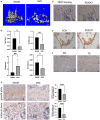Identification of PDXDC1 as a novel pleiotropic susceptibility locus shared between lumbar spine bone mineral density and birth weight
- PMID: 35314877
- PMCID: PMC9110509
- DOI: 10.1007/s00109-021-02165-0
Identification of PDXDC1 as a novel pleiotropic susceptibility locus shared between lumbar spine bone mineral density and birth weight
Abstract
An increasing number of epidemiological studies have suggested that birth weight (BW) may be a determinant of bone health later in life, although the underlying genetic mechanism remains unclear. Here, we applied a pleiotropic conditional false discovery rate (cFDR) approach to the genome-wide association study (GWAS) summary statistics for lumbar spine bone mineral density (LS BMD) and BW, aiming to identify novel susceptibility variants shared between these two traits. We detected 5 novel potential pleiotropic loci which are located at or near 7 different genes (NTAN1, PDXDC1, CACNA1G, JAG1, FAT1P1, CCDC170, ESR1), among which PDXDC1 and FAT1P1 have not previously been linked to these phenotypes. To partially validate the findings, we demonstrated that the expression of PDXDC1 was dramatically reduced in ovariectomized (OVX) mice in comparison with sham-operated (SHAM) mice in both the growth plate and trabecula bone. Furthermore, immunohistochemistry assay with serial sections showed that both osteoclasts and osteoblasts express PDXDC1, supporting its potential role in bone metabolism. In conclusion, our study provides insights into some shared genetic mechanisms for BMD and BW as well as a novel potential therapeutic target for the prevention of OP in the early stages of the disease development. KEY MESSAGES : We investigated pleiotropy-informed enrichment between LS BMD and BW. We identified genetic variants related to both LS BMD and BW by utilizing a cFDR approach. PDXDC1 is a novel pleiotropic gene which may be related to both LS BMD and BW. Elevated expression of PDXDC1 is related to higher BMD and lower ratio n-6/n-3 PUFA indicating a bone protective effect of PDXDC1.
Keywords: Birth weight; Bone mineral density; Conditional false discovery rate; Osteoporosis; Pleiotropy.
© 2022. The Author(s).
Conflict of interest statement
The authors declare no competing interests.
Figures






Similar articles
-
Genetic sharing with coronary artery disease identifies potential novel loci for bone mineral density.Bone. 2017 Oct;103:70-77. doi: 10.1016/j.bone.2017.06.016. Epub 2017 Jun 23. Bone. 2017. PMID: 28651948 Free PMC article.
-
Enhanced Identification of Potential Pleiotropic Genetic Variants for Bone Mineral Density and Breast Cancer.Calcif Tissue Int. 2017 Nov;101(5):489-500. doi: 10.1007/s00223-017-0308-x. Epub 2017 Jul 31. Calcif Tissue Int. 2017. PMID: 28761973 Free PMC article.
-
Identification of novel variants associated with osteoporosis, type 2 diabetes and potentially pleiotropic loci using pleiotropic cFDR method.Bone. 2018 Dec;117:6-14. doi: 10.1016/j.bone.2018.08.020. Epub 2018 Aug 30. Bone. 2018. PMID: 30172742 Free PMC article.
-
Genetic Pleiotropy of Bone-Related Phenotypes: Insights from Osteoporosis.Curr Osteoporos Rep. 2020 Oct;18(5):606-619. doi: 10.1007/s11914-020-00618-y. Curr Osteoporos Rep. 2020. PMID: 32897508 Review.
-
HDL cholesterol and bone mineral density: is there a genetic link?Bone. 2012 Feb;50(2):525-33. doi: 10.1016/j.bone.2011.07.002. Bone. 2012. PMID: 21810493 Free PMC article. Review.
Cited by
-
Causal effect of polyunsaturated fatty acids on bone mineral density and fracture.Front Nutr. 2022 Dec 8;9:1014847. doi: 10.3389/fnut.2022.1014847. eCollection 2022. Front Nutr. 2022. PMID: 36570136 Free PMC article.
References
-
- Wright NC, Looker AC, Saag KG, Curtis JR, Delzell ES, Randall S, Dawson-Hughes B. The recent prevalence of osteoporosis and low bone mass in the United States based on bone mineral density at the femoral neck or lumbar spine. J Bone Miner Res Off J Am Soc Bone Miner Res. 2014;29:2520–2526. doi: 10.1002/jbmr.2269. - DOI - PMC - PubMed
Publication types
MeSH terms
Substances
Grants and funding
LinkOut - more resources
Full Text Sources
Medical
Molecular Biology Databases
Miscellaneous

